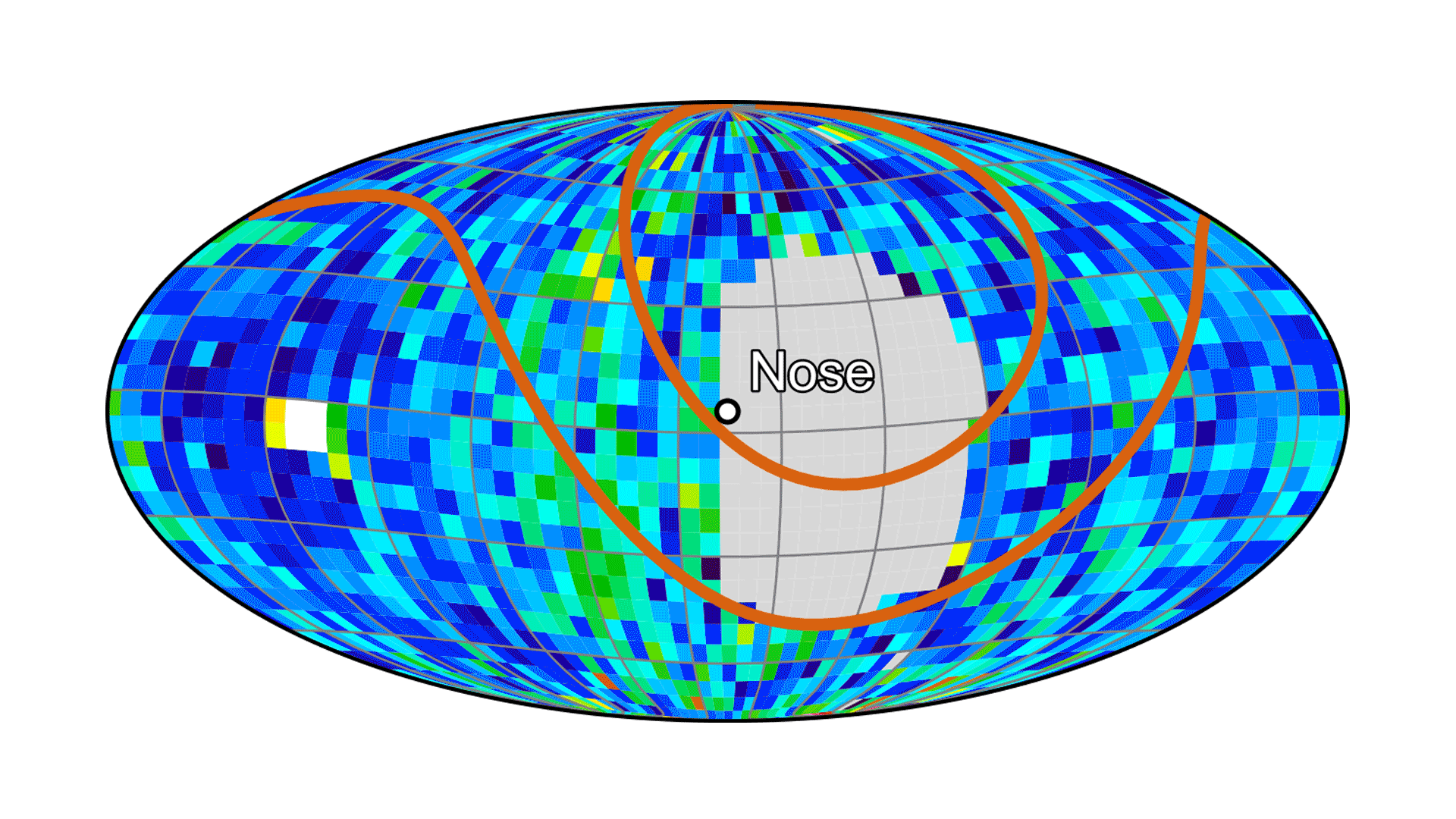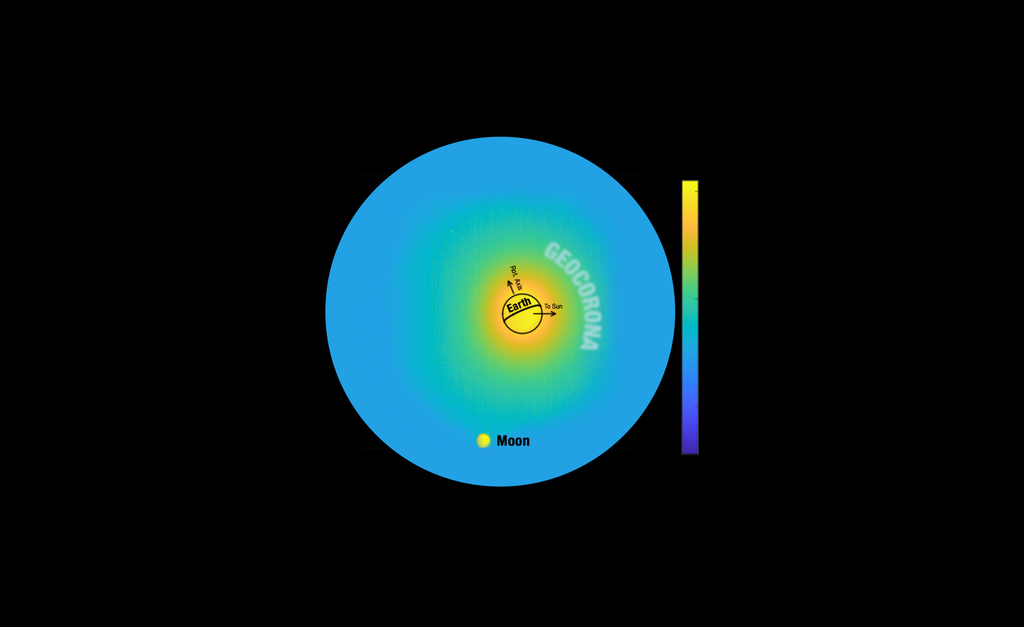On April 4, 1968, the second Saturn V rocket thundered off its launch pad to begin the Apollo 6 mission, the second uncrewed test of the Moon rocket and Apollo spacecraft. Following two successful uncrewed test flights – Apollo 4, the first all-up flight of the Saturn V rocket and Apollo Command and Service Modules (CSM), and Apollo 5, the first orbital test of the Lunar Module (LM) – Apollo 6 gave a somewhat troubled performance. Excessive vibration during the first stage powered flight caused some minor damage and an onboard crew would have experienced discomfort. Two of the second stage engines shut down prematurely and the third stage did not reignite for its second burn, forcing an alternate mission. Recovery teams retrieved the capsule from the Pacific Ocean.
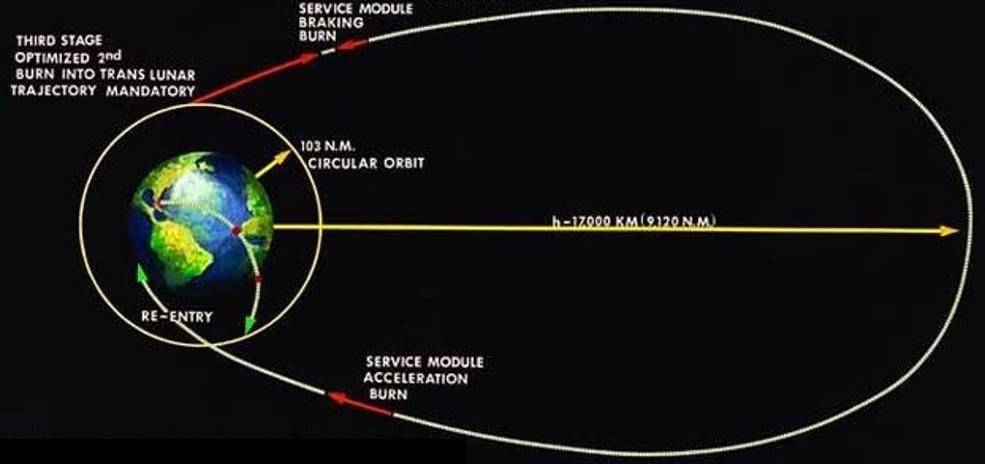
The Apollo 6 mission plan.
As planned, the Apollo 6 mission called for the first three stages of the Saturn V to place the CSM, still attached to the third stage, into a 115-mile-high circular Earth orbit. After two orbits to ensure the proper working of all vehicle systems, the third stage would reignite for more than five minutes to simulate a Translunar Injection (TLI) burn, sending the spacecraft into a highly elliptical Earth orbit with a high point of about 320,000 miles. Three minutes after the TLI burn, the combined third stage and spacecraft would turn itself around and the CSM would separate from the third stage that would continue into deep space. The Service Module (SM) engine now facing in the direction of travel would fire for about four minutes to slow the spacecraft down in a simulation of a direct-return abort. The maneuver would lower the high point of Apollo 6’s orbit to about 14,000 miles before the spacecraft descended back toward Earth. As it approached Earth, the SM engine would fire again for about three minutes to increase the spacecraft’s speed on reentry to about 25,000 miles per hour to simulate a return from the Moon. The mission would end with a splashdown in the Pacific Ocean after a flight of just under 10 hours.
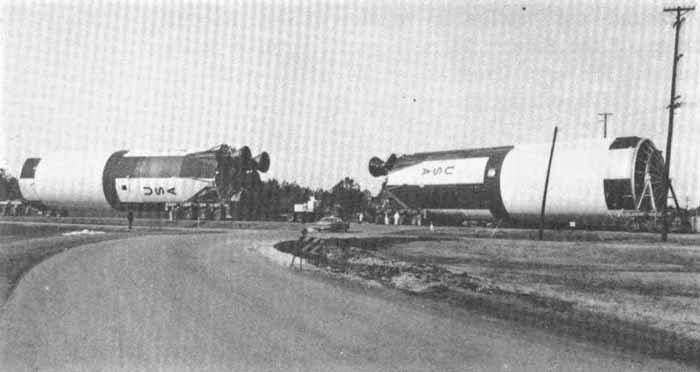
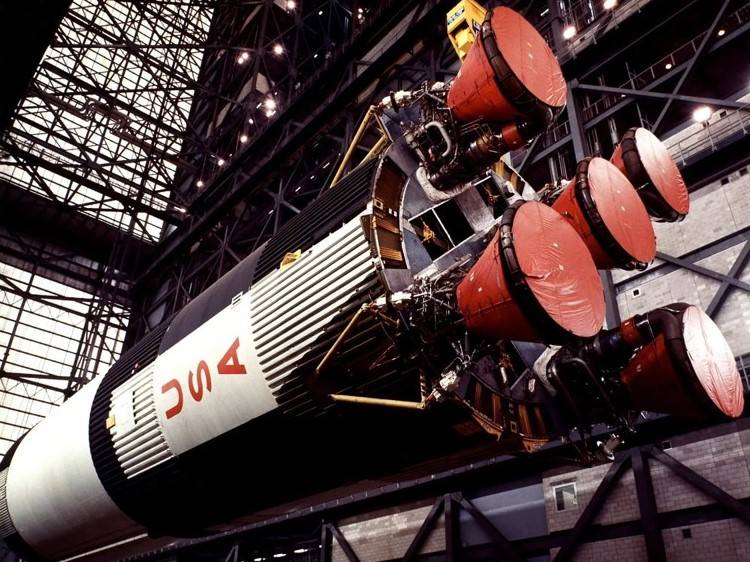
Left: The S-IC first stages of the Apollo 4, left, and Apollo 6 Saturn V rockets at NASA’s Marshall Space Flight Center in Huntsville, Alabama, in January 1966. Right: The S-IC first stage for the Apollo 6 Saturn V in the Vehicle Assembly Building at NASA’s Kennedy Space Center in Florida in March 1967.
Assembly of the Apollo 6 Saturn V rocket began with the arrival of the S-IVB third stage in the Vehicle Assembly Building (VAB) at NASA’s Kennedy Space Center in Florida on Feb. 21, 1967, followed by the S-IC first stage on March 13 and its erection on Mobile Launcher 2 in High Bay 3 four days later. Because of a two-month delay in the delivery of the S-II second stage, stacking operations on March 29 used a spool-shaped spacer instead of the second stage in order to carry out initial fit and function tests. After the delayed arrival of the S-II stage on May 24, and subsequent inspection for cracks in the stage’s hydrogen tank, workers removed the spacer and replaced it with the flight stage on July 13. In parallel activities, workers in High Bay 1 continued to assemble the Apollo 4 rocket, marking the first time they processed two Saturn V rockets at the same time. Because Apollo 4 activities took priority, engineers often had to delay work on the Apollo 6 vehicle.
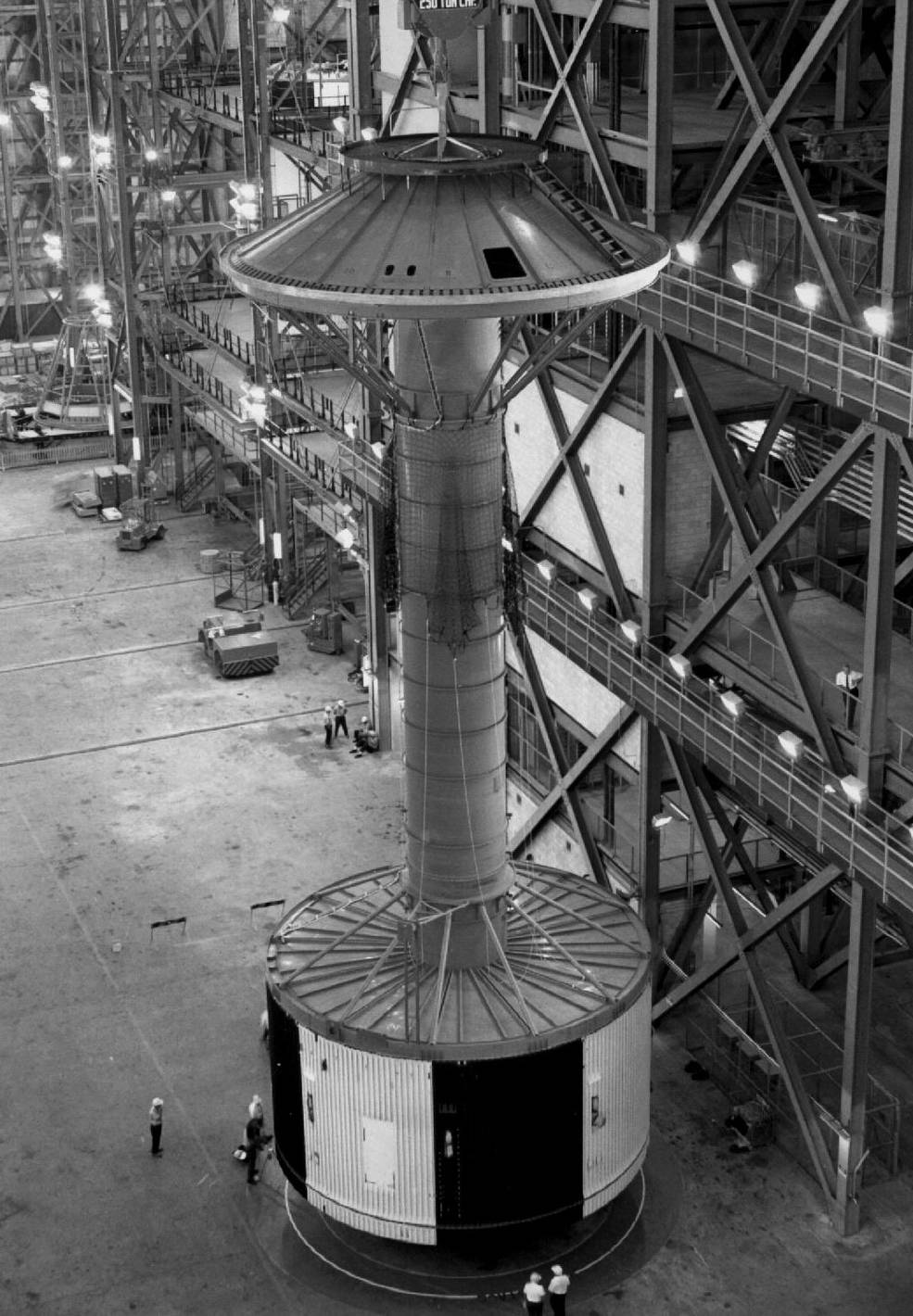
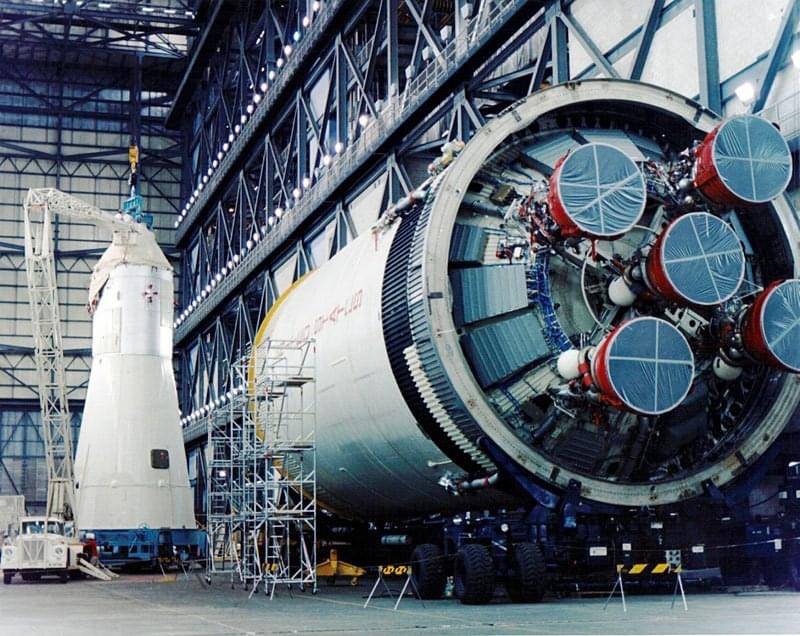
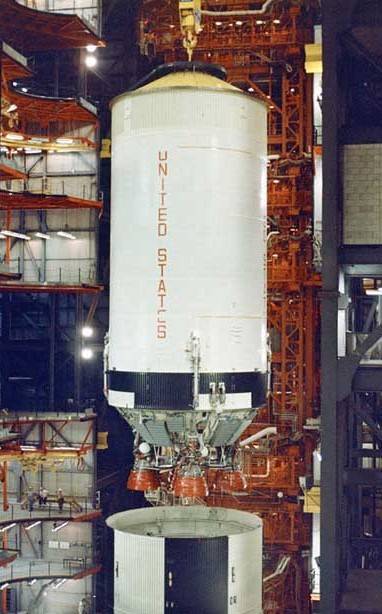
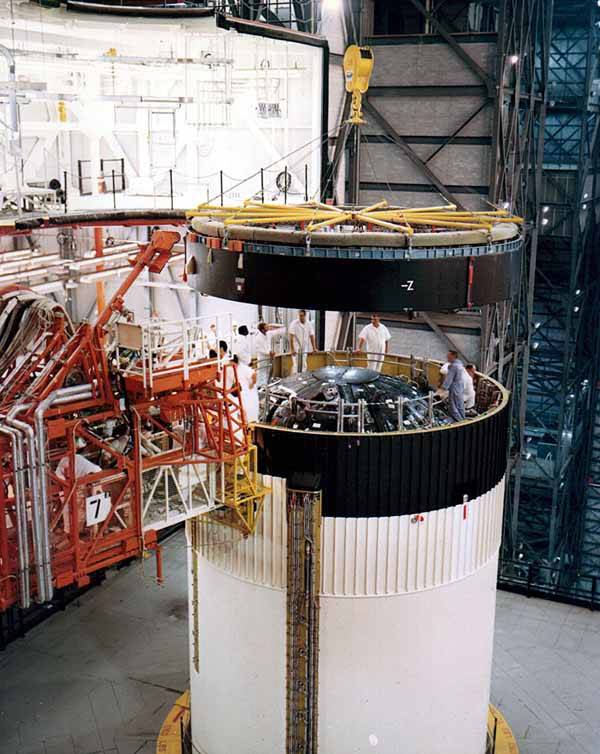
Assembly of the Apollo 6 Saturn V in the Vehicle Assembly Building at NASA’s Kennedy Space Center in Florida.
Left: The S-II second stage spacer. Middle left: The S-II second stage for Apollo 6 at right, as workers
prepare to lift the Apollo 4 spacecraft onto its Saturn V in June 1967. Middle right: Workers lower
the S-II stage onto the S-IC first stage. Right: Workers lower the
Instrument Unit onto the S-IVB third stage.
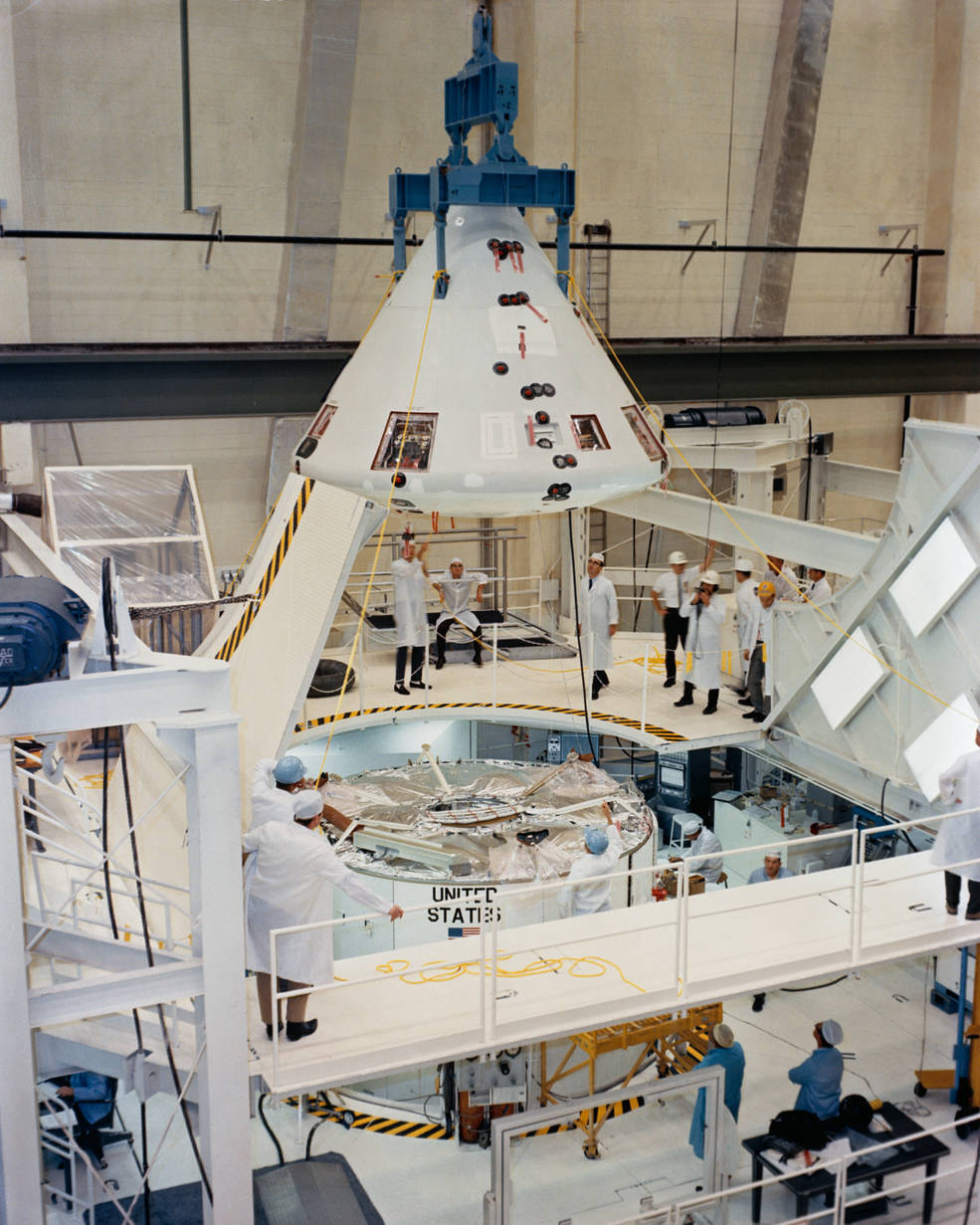
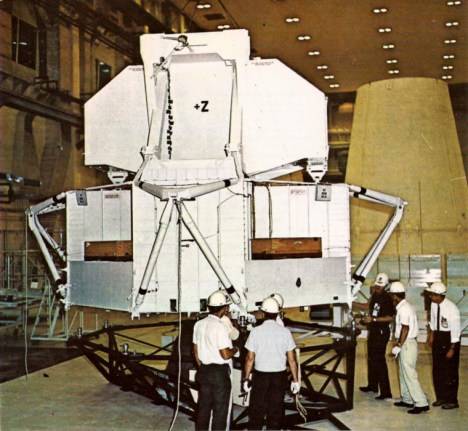
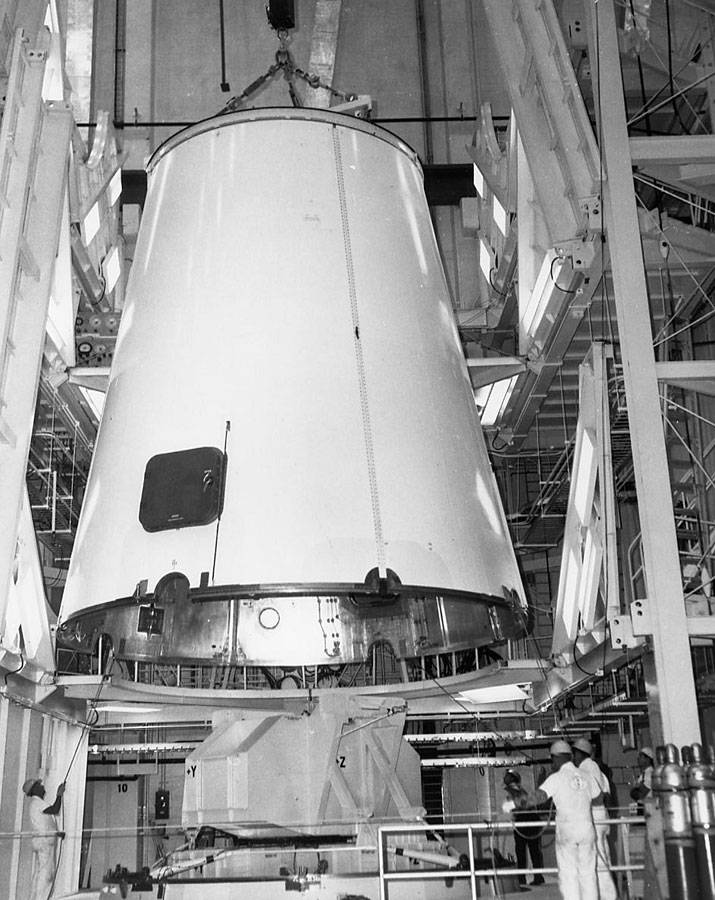
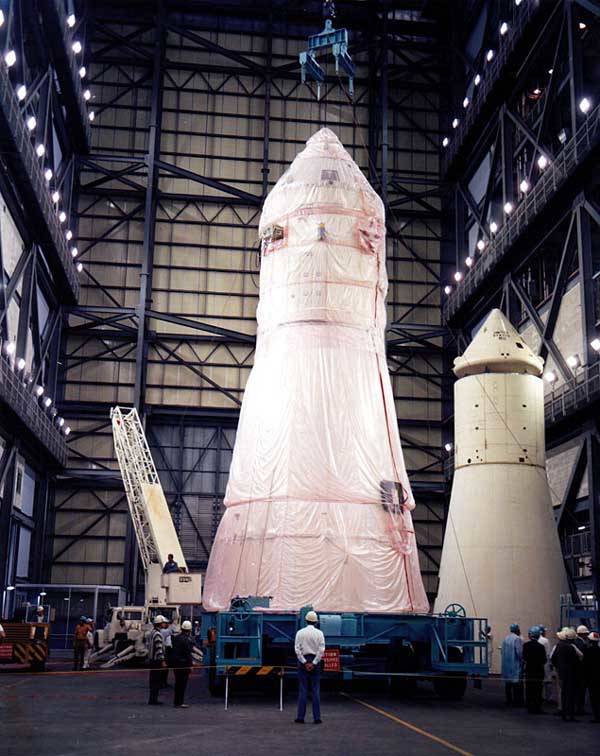
Preflight processing of the Apollo 6 spacecraft in the Manned Spacecraft Operations Building (MSOB) at NASA’s
Kennedy Space Center (KSC) in Florida. Left: Workers lower the Command Module onto the Service Module.
Middle left: Workers prepare the Lunar Module (LM) Test Article-2R (LTA-2R). Middle right: Workers
lower the Spacecraft LM Adapter to enclose the LTA-2R. Right: Following transfer from the MSOB,
in KSC’s Vehicle Assembly Building, workers prepare to lift the Apollo 6 spacecraft
to stack it onto its Saturn V rocket.
The first component of the Apollo 6 spacecraft, the LM Test Article-2R (LTA-2R), arrived at KSC’s Manned Spacecraft Operations Building (MSOB) on Feb. 14, 1967. While no LM flew on Apollo 6, engineers placed the LTA-2R inside the Spacecraft LM Adapter (SLA) atop the rocket’s third stage, to roughly simulate the mass and dynamic properties of the LM. Engineers outfitted LTA-2R with sensors to record the vibration and acceleration environment during powered flight, with the test article remaining attached to the S-IVB third stage throughout the mission. The CSM arrived in the MSOB on Sept. 29 to undergo preflight testing, following which engineers placed the SLA over the LTA-2R and stacked the CSM on top. Workers trucked the assembled spacecraft to the VAB, mounted it atop the completed Saturn V on Dec. 10, and topped it with the Launch Escape System tower.
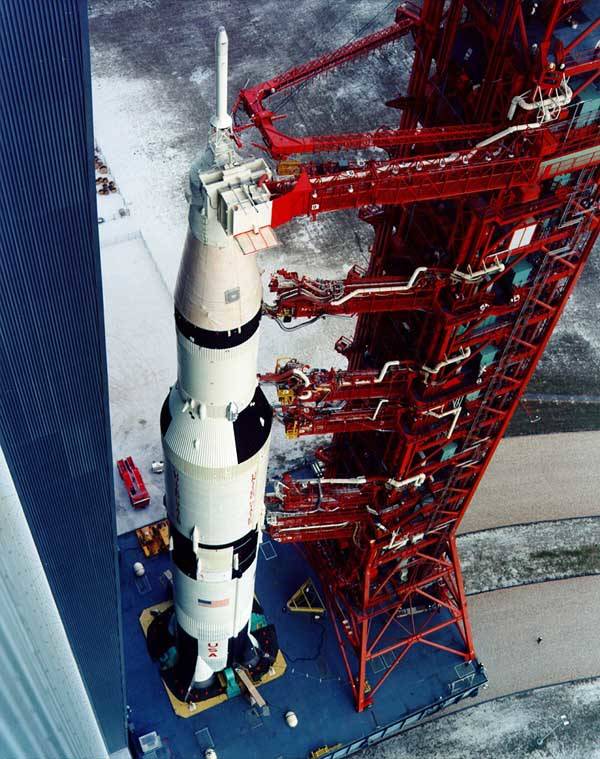
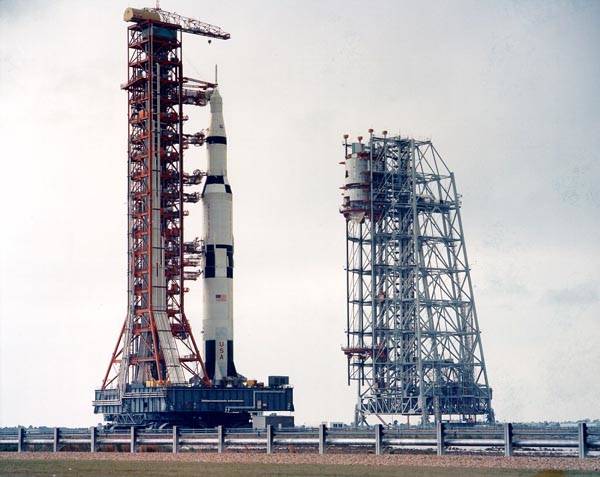
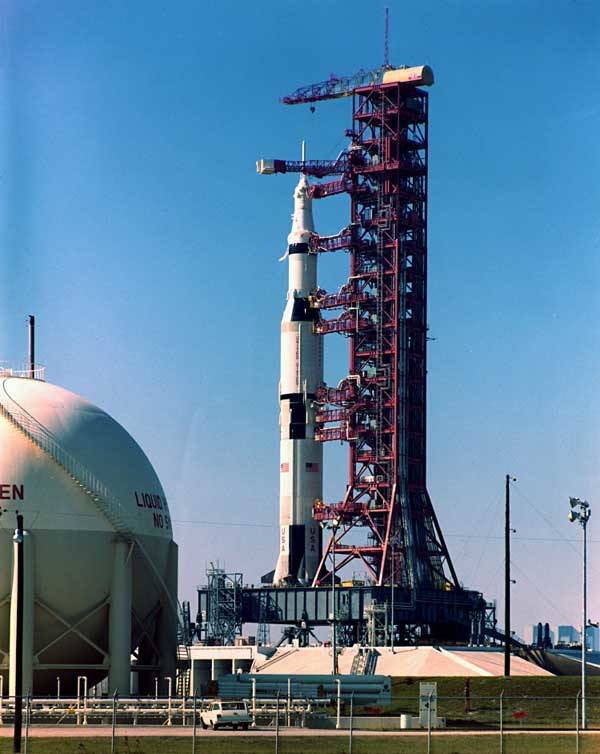
Left: The Apollo 6 Saturn V begins its rollout from the Vehicle Assembly Building at NASA’s Kennedy
Space Center in Florida. Middle: The Saturn V passes the parked Mobile Service Structure on its
way to Launch Pad 39A. Right: The Apollo 6 Saturn V on Launch Pad 39A.
Rollout of the Apollo 6 Saturn V took place on Feb. 6, 1968, the three-mile trip from the VAB to Launch Pad 39A interrupted by a two-hour weather-related delay. At the pad, engineers began tests of the launch vehicle, with the Flight Readiness Test completed on March 8. Senior managers concluded the Flight Readiness Review three days later, and engineers completed the weeklong Countdown Demonstration Test on March 31.
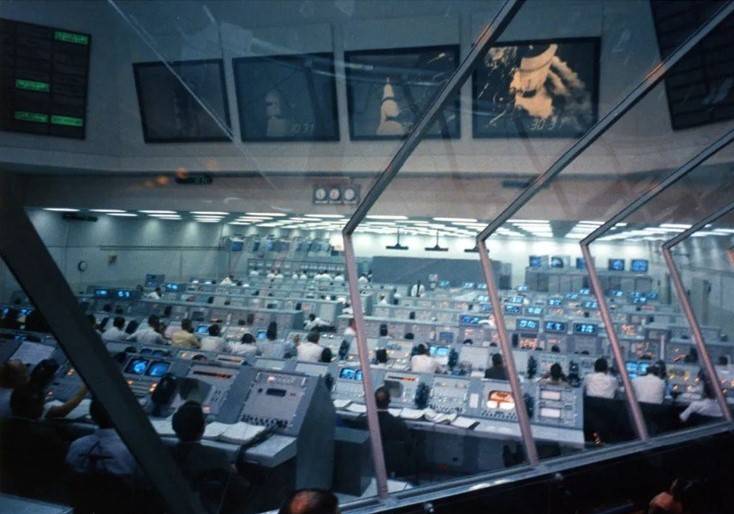
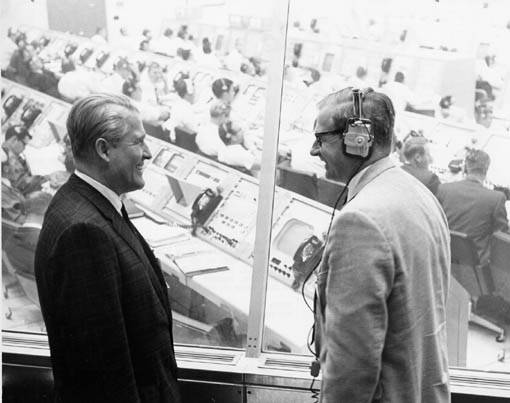
Left: View of the Launch Control Center (LCC) during the Apollo 6 countdown.
Right: Director of NASA’s Marshall Space Flight Center in Huntsville,
Alabama, Wernher von Braun, left, and NASA Deputy Administrator
Thomas O. Paine in the LCC await the launch of Apollo 6.
Engineers in Firing Room 2 of KSC’s Launch Control Center (LCC) began the terminal countdown for Apollo 6 on April 3 and completed it without any unplanned holds. Newly sworn in NASA Deputy Administrator Thomas O. Paine along with directors of the major NASA field centers attended the final mission director’s review and watched the terminal countdown and launch from the LCC.
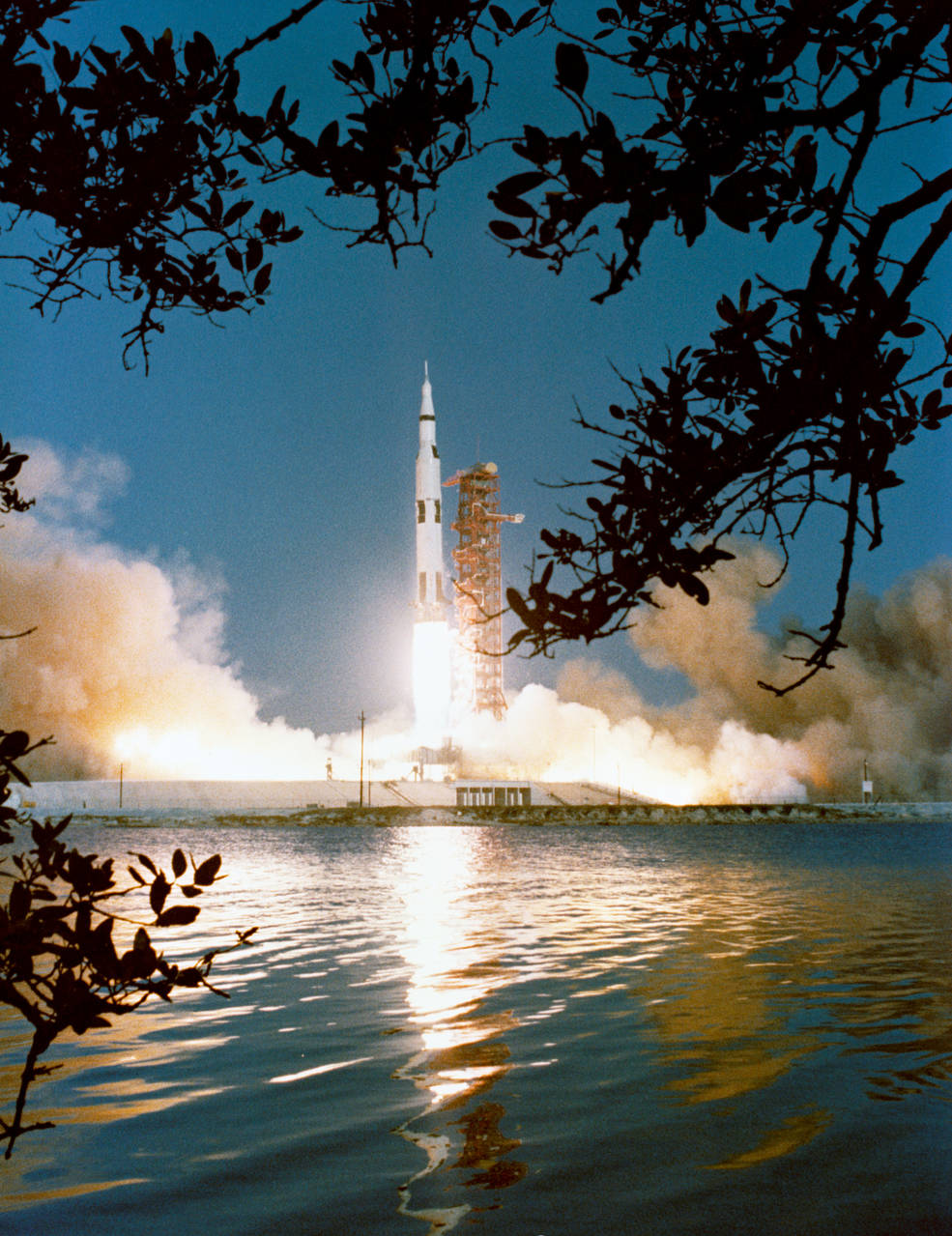
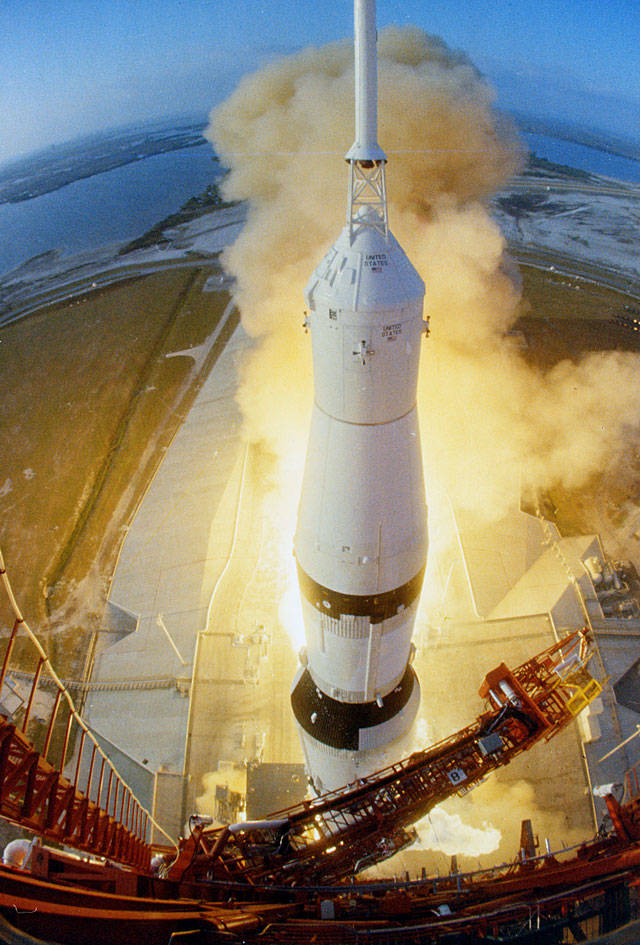
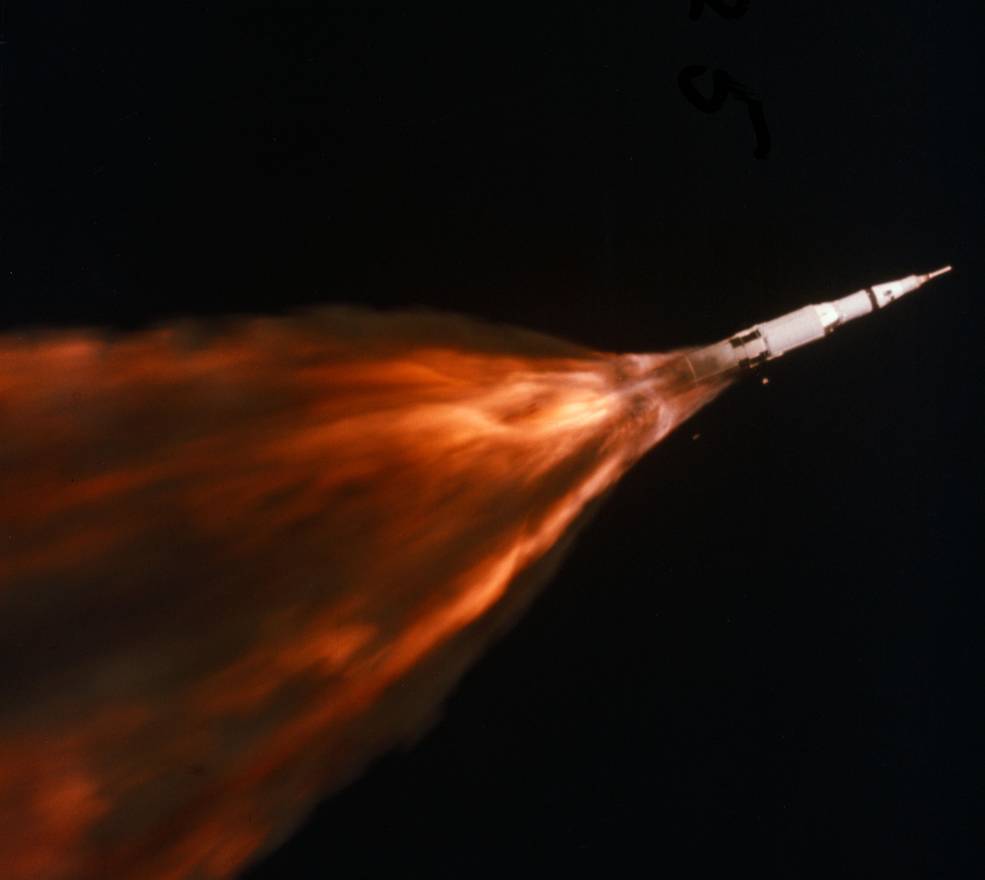
Left: Liftoff of Apollo 6 from Launch Pad 39A. Middle: Liftoff of Apollo 6 as seen from the launch
umbilical tower. Right: Excessive vibrations during the first stage powered flight caused
visible damage to the Spacecraft Lunar Module Adapter external panels.
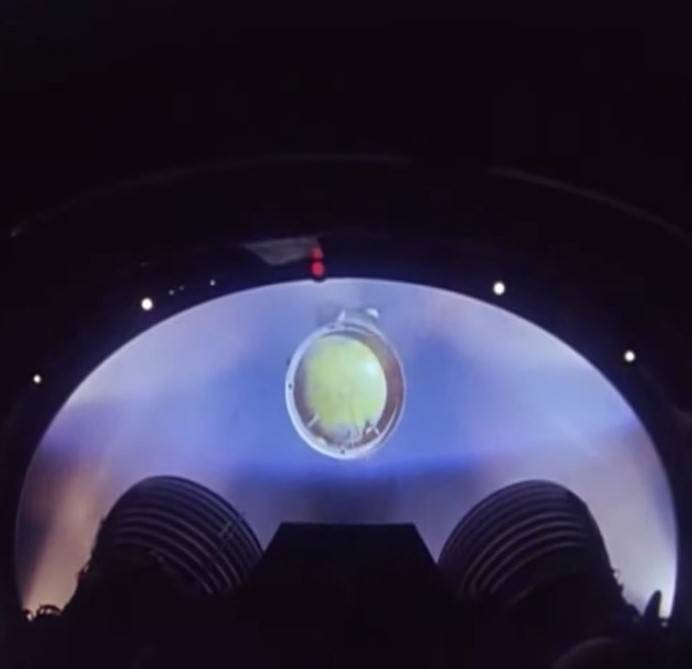
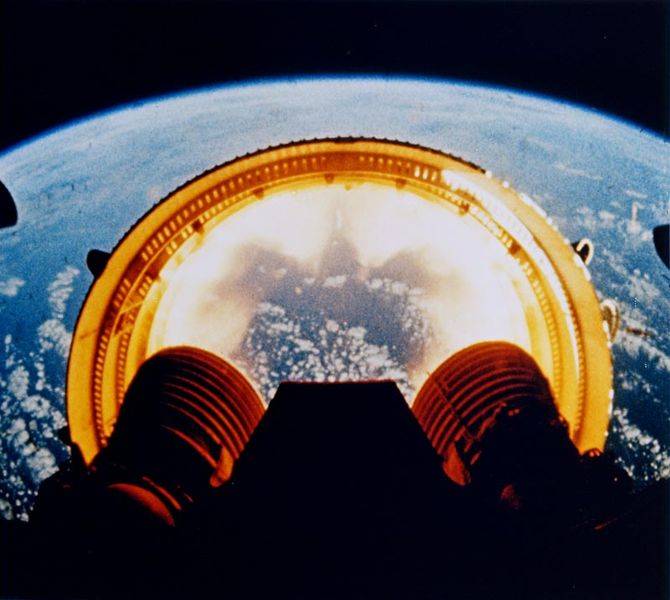
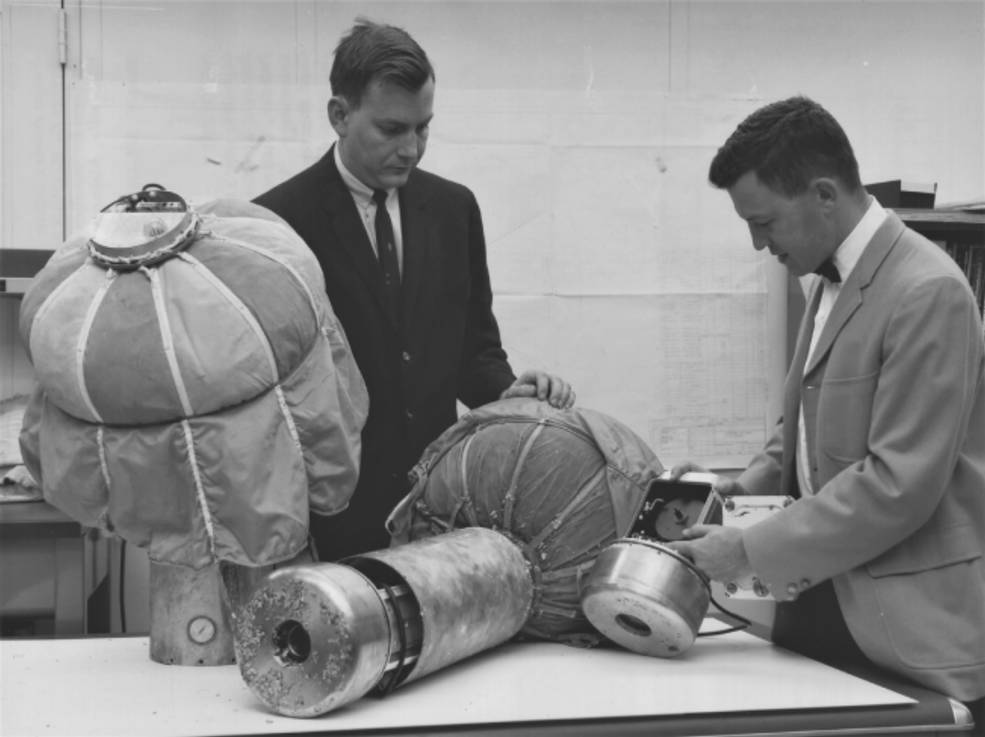
Left: A recoverable camera mounted inside the second stage captures the separation of the
Saturn V rocket’s first stage. Middle: The camera captures the jettison of the Interstage.
Right: Technicians examine a camera pod following its recovery.
The second Saturn V lifted off from KSC’s Launch Pad 39A on April 4, 1968. The mission ran into trouble from the start. Two minutes into the flight, the first stage experienced about 30 seconds of vertical oscillations known as “pogo effect,” that not only caused about 27 square feet of the SLA’s outer panels to come loose but would have caused great discomfort for any onboard astronauts. During the second stage burn, two of the five engines shut down prematurely. The remaining three engines burned longer to compensate for the reduced thrust, as did the third stage to propel Apollo 6 into orbit, although not the planned 115-mile circular orbit but an elliptical one 108 by 222 miles. When the time came for the third stage to restart, it simply didn’t. But it did execute its turnaround maneuver as if it had completed the burn, to place the spacecraft in position for its retrograde burn.
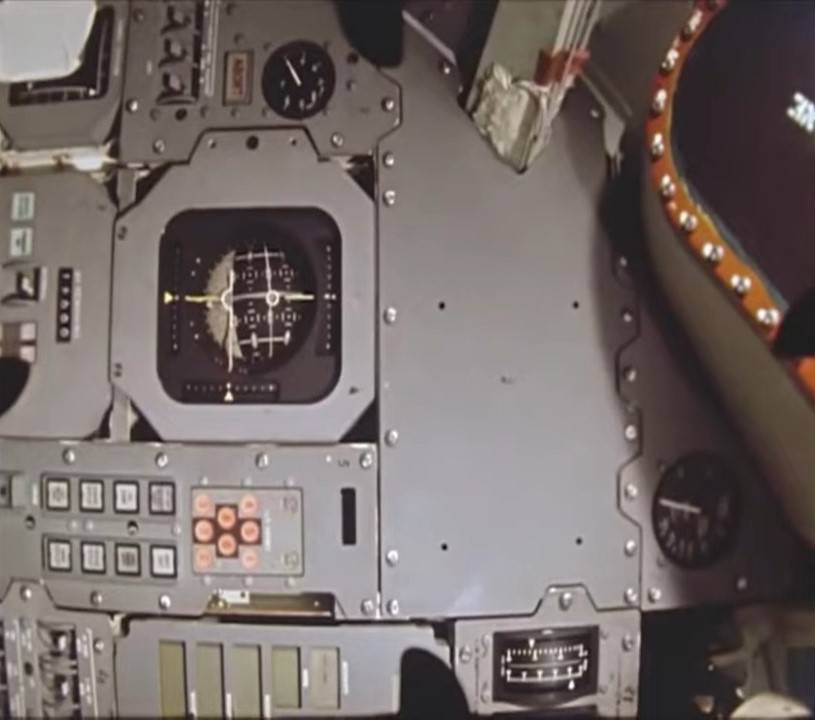
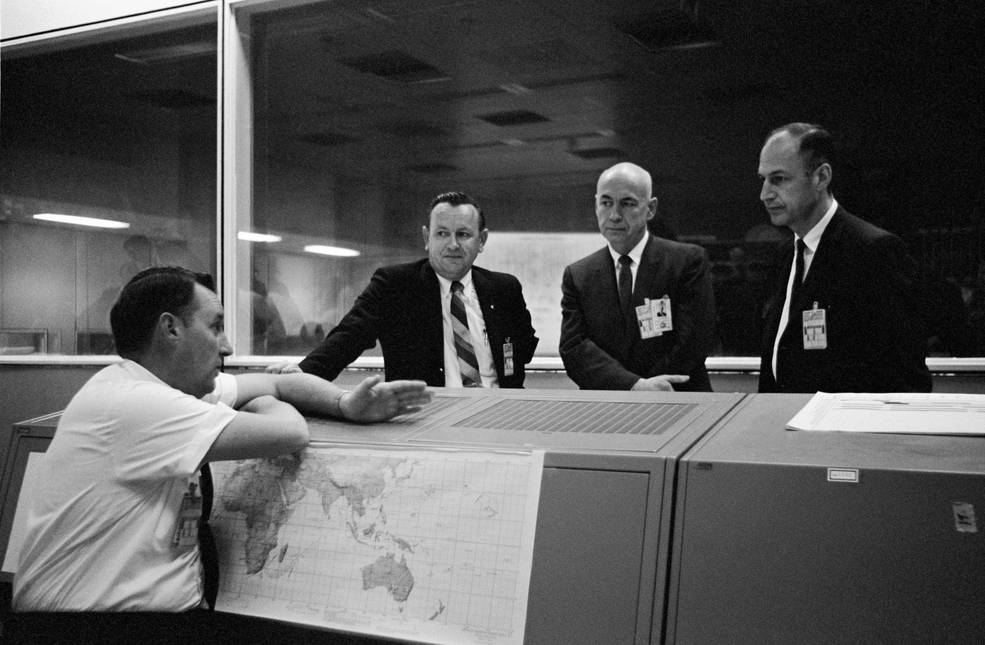
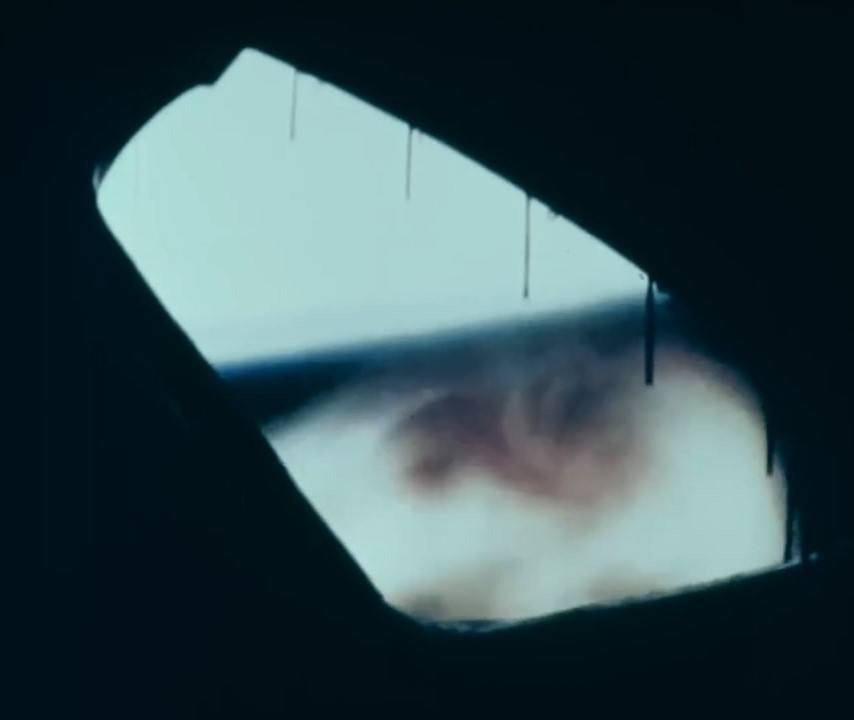
Left: Still image from a film taken by an onboard camera showing the Apollo 6 Command Module (CM)
control panel during the mission. Middle: In the Mission Control Center at the Manned Spacecraft
Center (MSC), now NASA’s Johnson Space Center in Houston, Flight Director Clifford E.
Charlesworth, left, confers with senior MSC managers Christopher C. Kraft, Robert R.
Gilruth, and George M. Low. Right: Still from a film taken through one of
the Apollo 6 CM windows during reentry into the Earth’s atmosphere.
In the Mission Control Center at the Manned Spacecraft Center, now NASA’s Johnson Space Center in Houston, the flight control team led by Flight Director Clifford E. Charlesworth decided to execute a preplanned alternate mission to separate the spacecraft from the third stage and use the SM engine to reach the nearly 14,000-mile altitude, the burn lasting 7 minutes 21 seconds. But this used so much fuel that the second planned SM burn to accelerate the spacecraft to lunar return velocity could not be carried out. Reentry occurred at 22,380 miles per hour, somewhat less than the planned velocity.
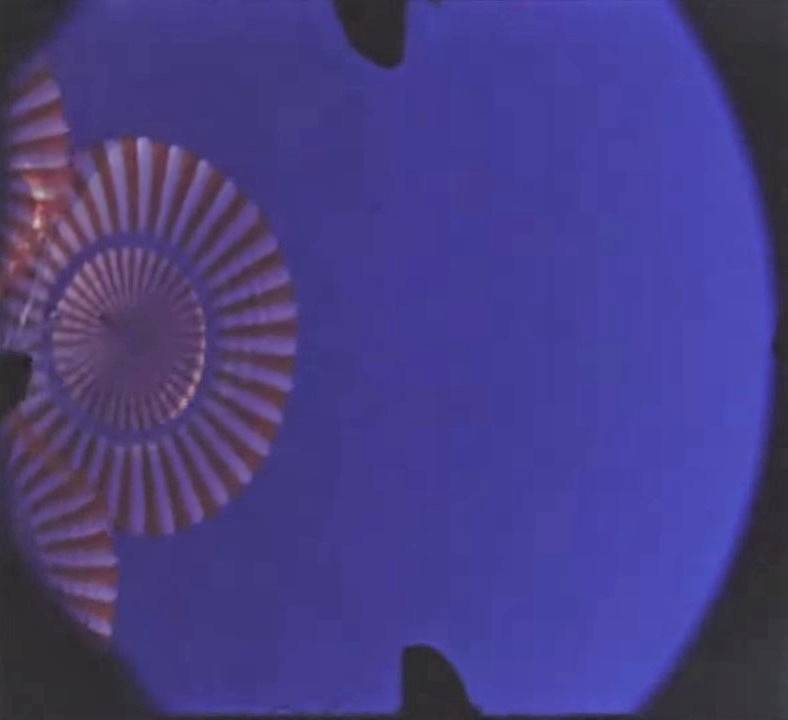
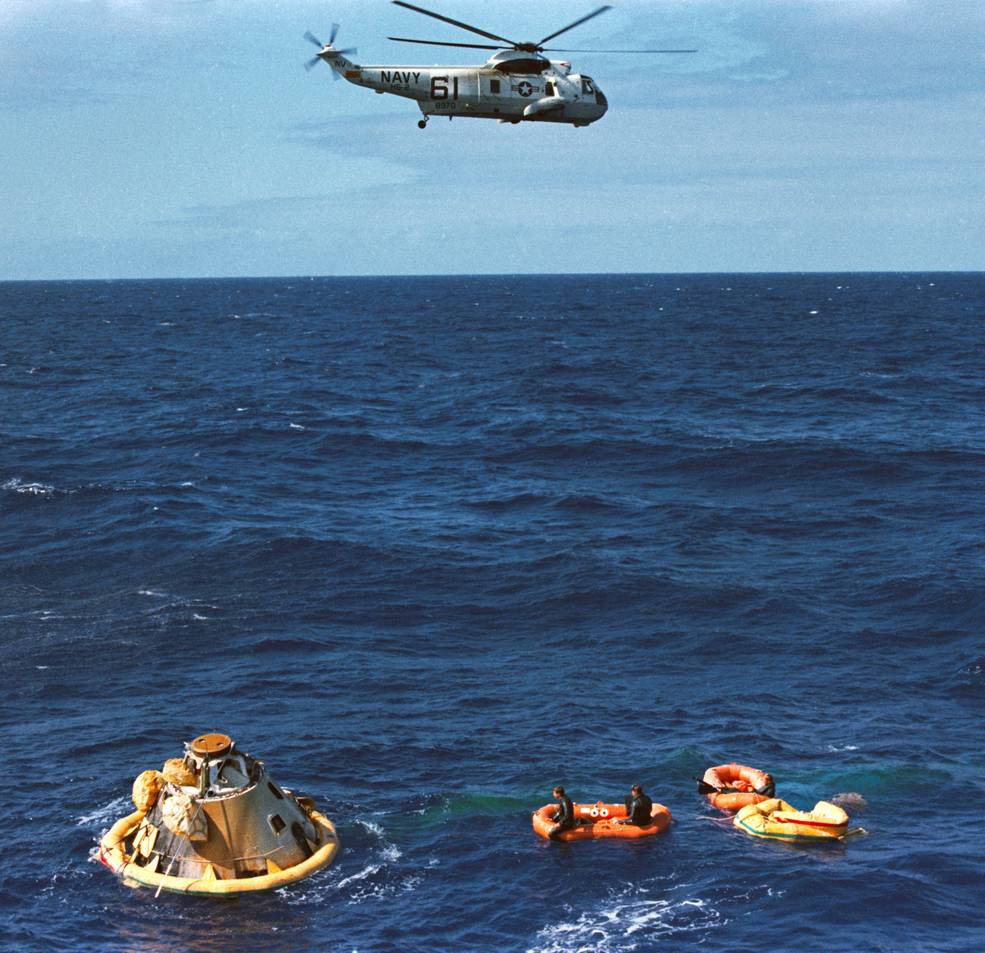
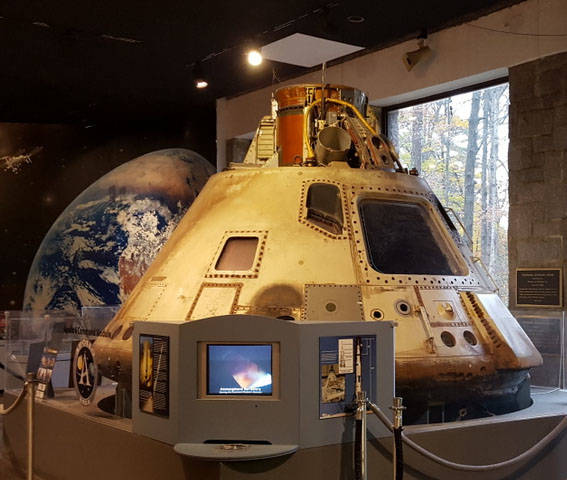
Left: The three main parachutes as recorded by an onboard movie camera. Middle: The Apollo 6 Command
Module (CM) shortly after splashdown and during recovery operations by the U.S.S. Okinawa.
Right: The Apollo 6 CM on display at the Fernbank Science Center in Atlanta.Image credit: courtesy Fernbank Science Center.
After reentry and the normal deployment of the parachutes, Apollo 6 splashed down in the Pacific Ocean north of Hawaii after a troubled flight of 9 hours and 57 minutes. The altered mission led to the capsule splashing down 56 miles from the prime recovery ship the helicopter carrier U.S.S Okinawa (LPH-3). Recovery forces located the capsule 26 minutes after splashdown and helicopters dropped U.S. Navy swimmers to attach flotation collars around the capsule. Sailors retrieved the spacecraft onto the deck of the ship about six hours after splashdown. The Navy returned the CM to its manufacturer, the North American plant in Downey, California, for postflight inspection. The Apollo 6 CM is on display at the Fernbank Science Center in Atlanta. The spent S-IVB third stage, stranded in Earth orbit instead of sailing off into solar orbit, burned up on reentry into the Earth’s atmosphere on April 26, 1968.
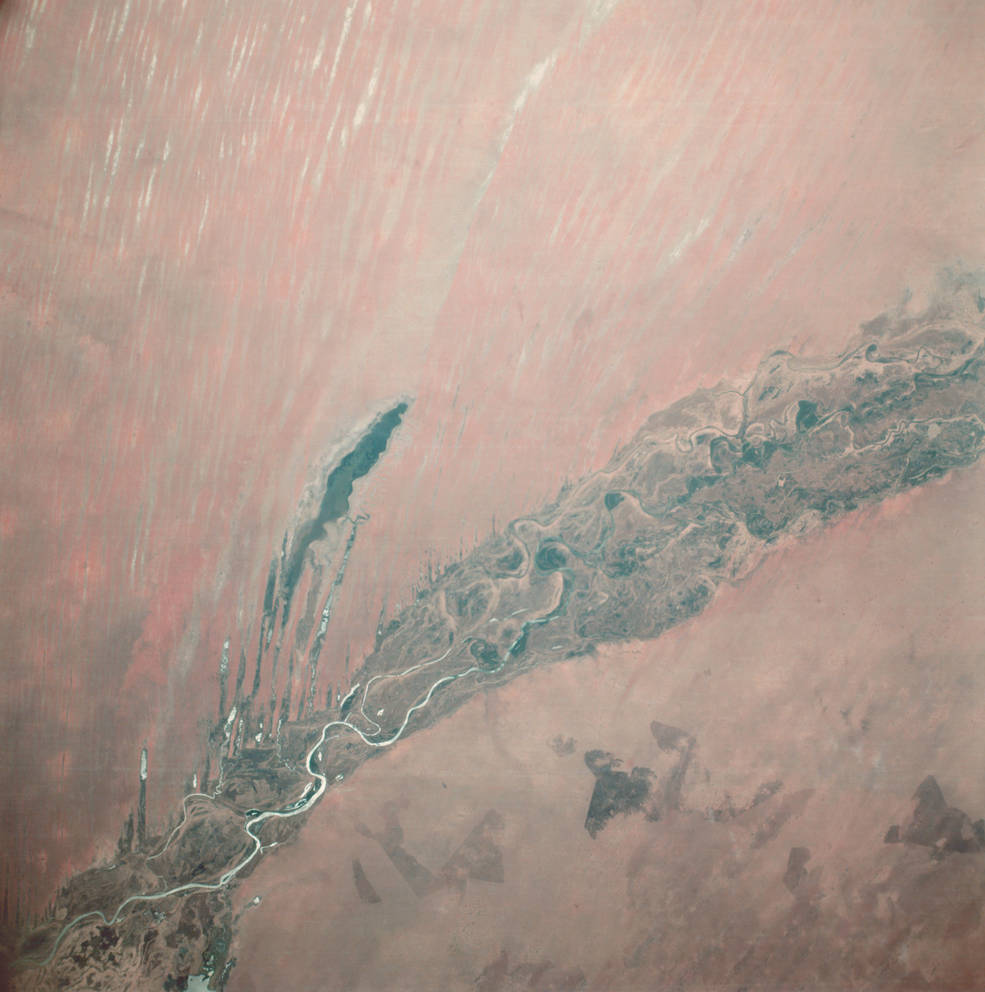
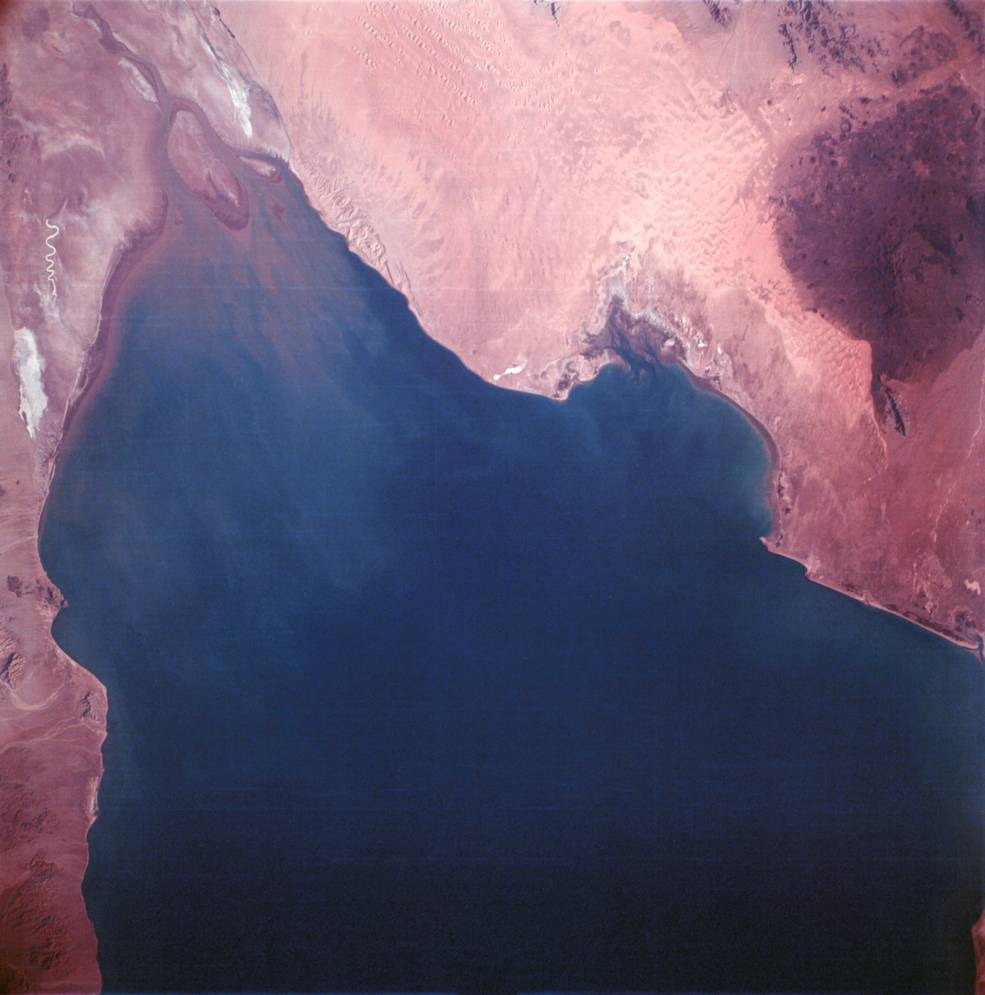
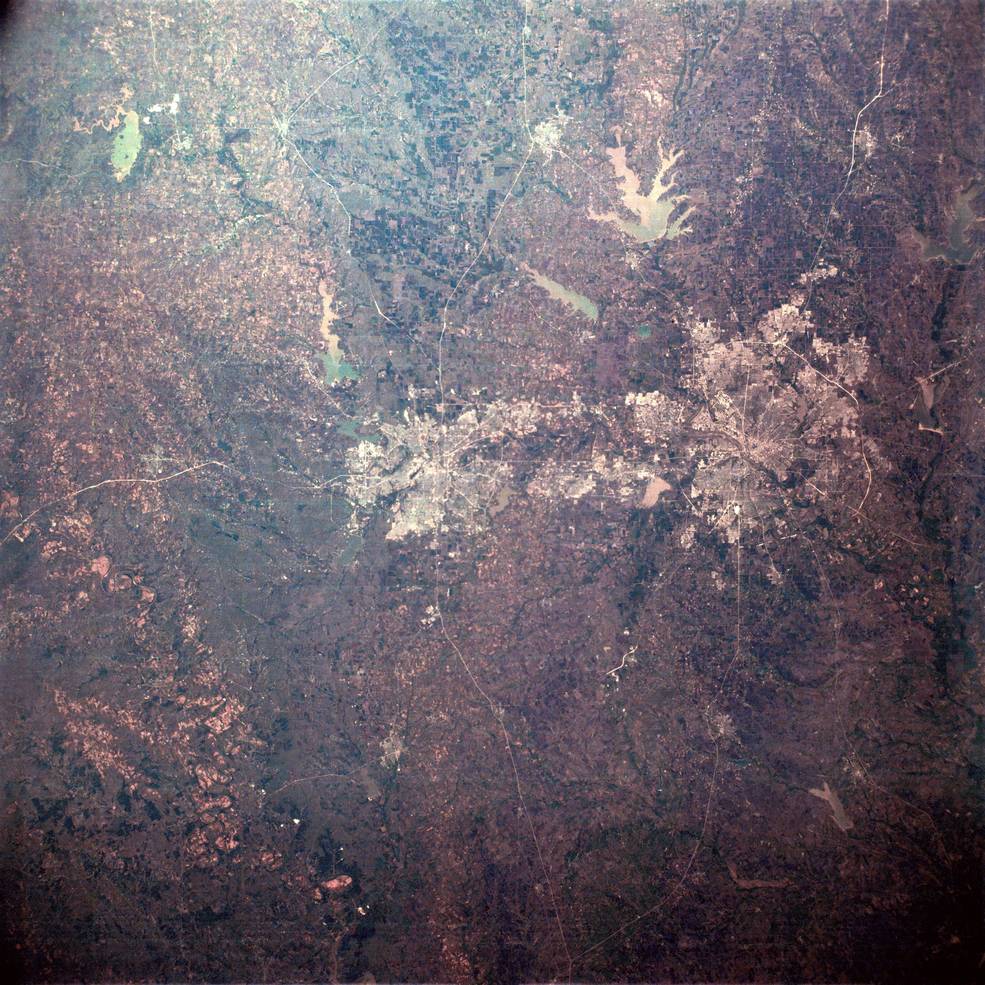
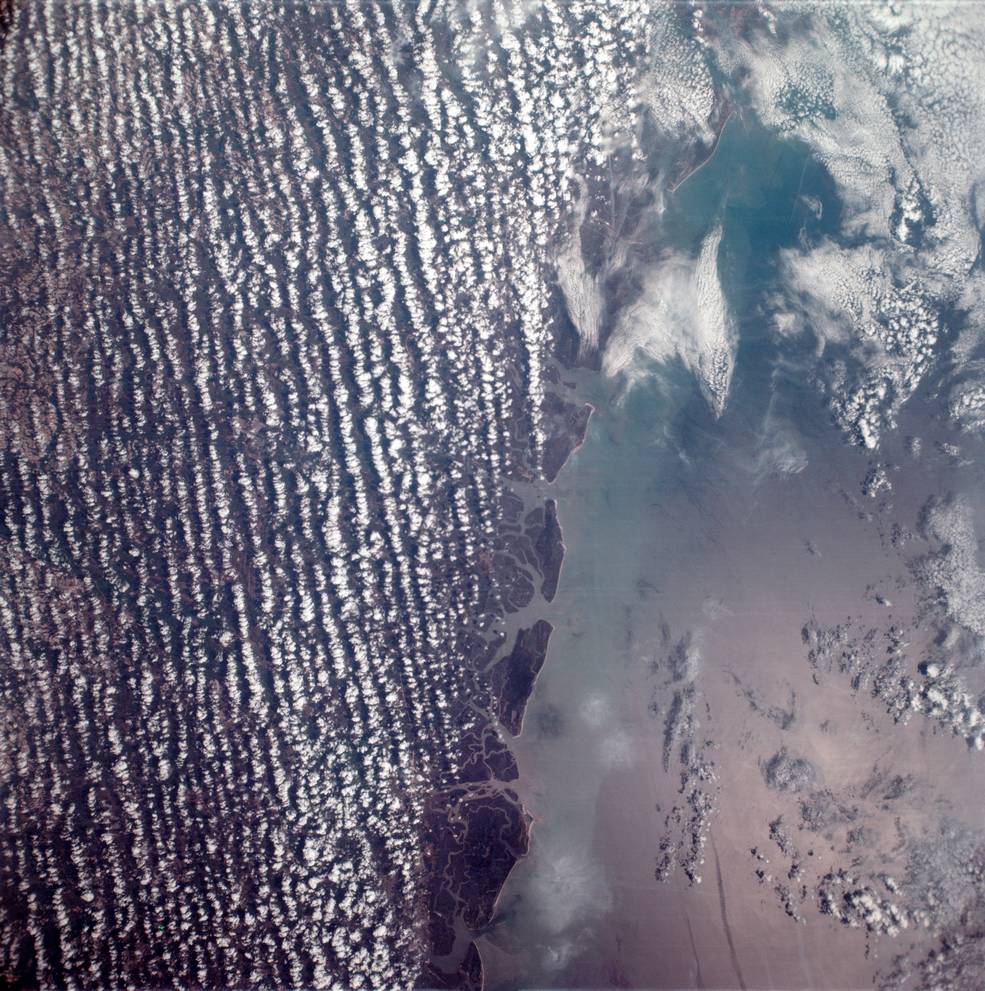
A sampling of the hundreds of high-quality Earth photographs taken by Apollo 6. Left: The Senegal River as it courses through Senegal and Mauritania. Middle left: The Gulf of California with the mouth of the Colorado River.
Middle right: The Dallas-Fort Worth area. Right: The Atlantic coast of Georgia.
The rocket problems notwithstanding, Apollo 6 returned some stunning photographic results. Both the first stage and the second stage carried recoverable camera pods. The S-IC first stage carried two cameras to film stage separation and two to film the behavior of liquid oxygen in the tank. Three of the four first stage cameras failed to eject, but teams from the U.S.S. Austin (LPD-4) recovered the fourth, one of the two separation cameras, in the Atlantic Ocean. Two camera pods in the second stage recorded some stunning footage of the first stage separation, imagery that has become iconic of Saturn V launches (and often incorrectly attributed to Apollo 11). Recovery forces from the Austin could only find one of the pods since the locator beacon on the other pod failed. During its two orbits of the Earth, the spacecraft’s 70-millimeter window-mounted still camera obtained spectacular color stereo photographs. Scientists found them suitable for cartographic, topographic, and geographic studies of continental areas, coastal regions, and shallow waters. The camera photographed sections of the United States, the Atlantic Ocean, Africa, and the western Pacific Ocean, and had a haze-penetrating film and filter combination that provided better color balance and higher resolution than any photographs obtained during the Mercury and Gemini flights.
Apollo 6 garnered less than the usual press attention as major news events in the country overshadowed the mission. Only four days before the flight, President Lyndon B. Johnson announced to a stunned nation that he would not seek reelection in November 1968. About an hour after the Apollo 6 splashdown, an assassin’s bullet took the life of civil rights leader Rev. Martin Luther King in Memphis, Tennessee. Within NASA, the focus remained on accomplishing President John F. Kennedy’s goal of landing a man on the Moon before the end of the decade. After detailed analysis of the Saturn V’s less than perfect performance by engineers at NASA’s Marshall Space Flight Center in Huntsville, Alabama, senior managers decided they could solve the pogo issue and the engine malfunctions and that another unmanned test flight was not necessary – the next Saturn V would carry a crew! And as events unfolded, it was to be more than just the first crewed flight of the Moon rocket.












